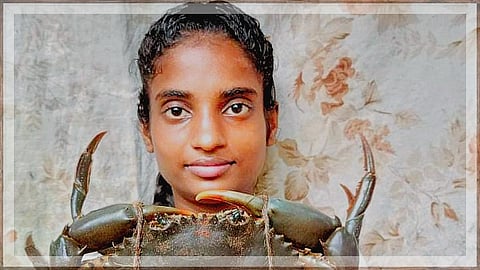Old Goa’s gutsy little crab catcher Bravina D’Souza lives up to her name
ANISHA FRANCIS
anisha@herald-goa.com
PANJIM: Bravina D’Souza of Old Goa isn’t your typical 22-year-old – for one, she’s not glued to her phone; and her wispy build belies both her age and her quiet strength of character. Earlier this year, Bravina decided to quit struggling in low-paying odd jobs and become a full-time crab catcher, depending only on the Mandovi River for sustenance.
“Now, I ask myself why I didn’t start this business earlier.
The feeling of independence you get when you only rely on yourself to earn a living, is unmatched,” she says, wise beyond her years.
“I had to start working quite early, tried several jobs – from domestic cleaning work to working at a beauty parlour,” says Bravina, who has completed her SSC. “Very often, I found that employers don’t care about you, they don’t understand
your problems. I often would not get paid on time, or fully,” she says.
The eldest of three girls, Bravina hasn’t had it easy. Her father, an autorickshaw driver, passed away after a heart attack in 2022, while her mother has been chronically ill. Bravina says her happiest childhood memories are days spent fishing with her father. “I used to accompany my father to Divar for angling and crabbing. We used to go very often; my sisters would also come along sometimes. He taught us how to fish with rods and hooks,” she recalls.
After her father’s death, Bravina’s mother and her sisters, aged 20 and 17, found refuge in a shelter home, but Bravina decided to live on her own, and work to help support them – medicines are expensive, she points out. “When I realised I was getting nowhere at my job at the salon, and could barely make ends meet – my house was leaking and sometimes, I would eat only if I went fishing. I decided to quit and start catching freshwater crabs to sell at Gandhi Circle,” she says. Bravina purchased the crabbing nets – Cobli – from Panjim market and began her daily routine of riding the ferry to Divar with her cycle, and then walking along the bundhs and edges of the island to install her nets. She adds that she can’t fish at the sluice gates as they are leased out. She uses chicken heads and feet as bait.
“These days, I go fishing only around noon, after cooking rice and dal and having lunch. I stay on the island until sundown and return around 7 pm. On the way back, I call my regular
customers to offer them my catch, and they readily come and collect it from me. Most of my crabs are sold this way, directly to seafood lovers,” she says, proud of her networking skills. Only when I have excess crabs or catfish, I sell at the junction,” she says. “The other day, I netted around 7 kg of crabs. My best catch in a single day was probably around 10 kg. The biggest crab I’ve caught weighed 650 grams,” she rattles off, adding that she also encounters dangerous aquatic snakes quite often. She says she’s also grateful for encouragement from her well-wishers, and support from friends, like the kind ferry boat operator who helps her tie up the bigger crabs before they take a chunk out of her fingers.
Bravina dreams of stability for herself and her sisters, determined to keep her father’s spirit alive through the family’s connection to the water. As she looks to the future, the soft-spoken youngster hopes to grow her crabbing business, setting an example of resilience and independence for her sisters.

